Read Our Blogs
Pawpaws are the star of Inaugural Festival held at Powhatan State Park
Have you heard of Pawpaws? They are the nation’s largest fruit and they can be found on trees at Powhatan State Park. The park wants to showcase this magnificent tree and highlight its importance and impact on the park.
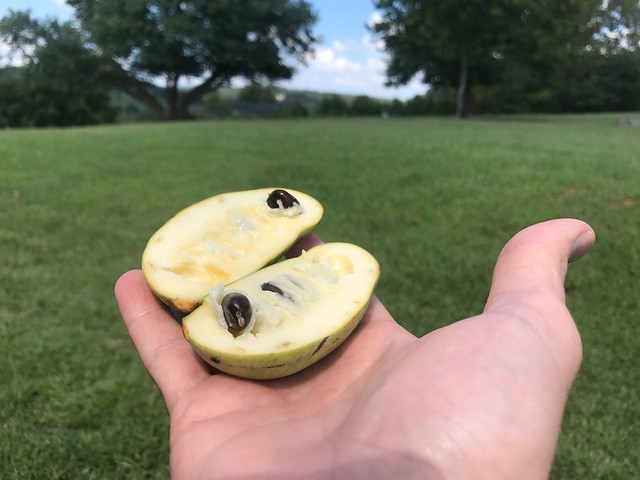
In honor of the park’s 10th Anniversary, there are some activities planned this month so you can join in on the festivities.
Pawpaw Festival
First up for the park’s anniversary celebration is the Inaugural Pawpaw Festival that will be held on Saturday, Sept. 16 from 11 a.m. until 3 p.m. at multiple locations throughout the park. Guests will be able to hear live music performances, participate in ranger-led programs and experience animal presentations.
“We are excited to debut this event and highlight this wonderful fruit that grows right here on trees in our park,” said Powhatan State Park Manager Amelia Hulth. “We hope to spread more awareness about the Pawpaws and have fun while we do that. You won’t want to miss the guided hike at 1 p.m. for a chance to pick and possibly eat a ripe pawpaw fruit.”

You will be able to try your hand at shooting an arrow or throwing a spear in a ranger-guided workshop. There are three archery and atlatl spear throwing sessions that are held at 11:30 a.m., 12:30 p.m. and 1:30 p.m. in the archery area of the park.
You will also be able to grow your own pawpaw by starting with a seed and learn what makes these trees thrive.
The event will include food and drink vendors, solar viewing, bee keeping and honey experts as well as master naturalist programs for all ages. Other activities include learning about camping and the gear required, experiencing the variety of birds and critters that call the park home as well as find out how water connects us to the wildlife and the whole world.
There will be something for the whole family to enjoy at this festival so be sure to add this to your calendar.
10th Anniversary 10-Miler Race
The second part of the park’s celebration is the 10th Anniversary 10-Miler race on September 23. This race is part of the Adventure Series and participants must register here to participate.
This race allows you to run along scenic trails featuring the James River, open fields, and a historic cabin. The trails feature a great mix of terrain for all fitness levels to enjoy. Along the river is flat, fast, and scenic, but when you veer away from the river, there are some gnarly inclines that lead to open fields. The views stretch for miles until you enter the forest, where you will run or walk through some shaded singletrack until you reach the historic cabin ruins. After a steep climb, you will eventually exit the forest and come back out into the open fields finishing your 10 miles back at the Equestrian Trailhead Parking Lot.
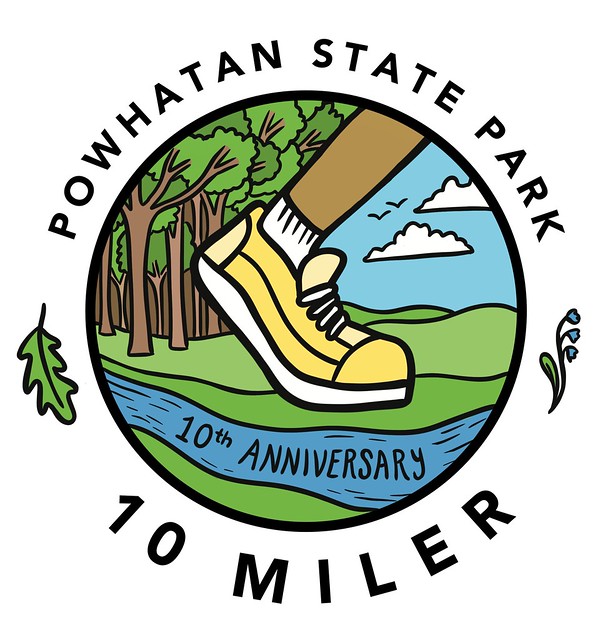
There will be a water station near mile five and food will be available to purchase after the event from the Cafe at Maidens. Box lunches will be offered and can be added on to your order at check out. All proceeds benefit the Friends of Powhatan State Park, a local volunteer organization dedicated to supporting the mission of Powhatan State Park.
“Celebrate the park’s anniversary and experience the beautiful scenery in this unique race series,” said Virginia State Park Promotions Manager Steve Boyd. “There are a few more races left this year so be sure to check out the website and register.”
For more information about these events reach out to Amelia Hulth via email at amelia.hulth@dcr.virginia.gov.
Pawpaw Trees and Flowers
Pawpaw trees are the largest edible fruit trees in North America and are enjoyed by humans and animals. They can also be found at Powhatan State Park.
Pawpaws are common in Virginia’s Coastal Plain and Piedmont regions as these trees can be found in forest bottomlands, well drained floodplain forests, swamp mounds and rich woods. They are an understory tree that reaches up to 40 ft in height and tend to gather into small colonies also known as Pawpaw patches.
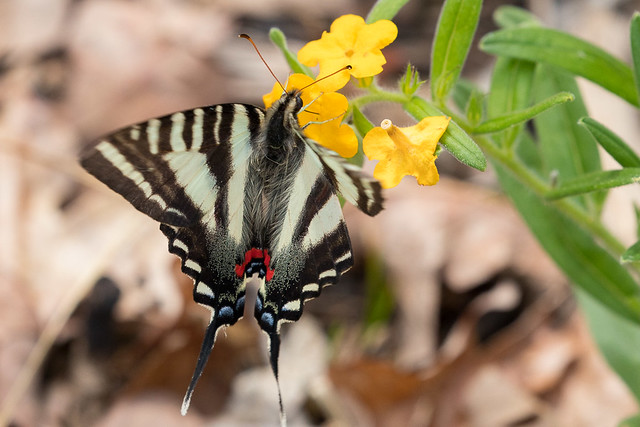
Pawpaws have a lot to offer year-round. In spring they bloom unique flowers, in early fall they grow delicious and highly nutritious fruit, and they are the only host plant of one of our most beautiful butterflies, the Zebra Swallowtail.
In early to mid-April, Pawpaws begin to bloom with a very distinctive flower. The small flowers are fascinating and hang from the bare branches like dark maroon bells. If you smell the flowers closely, you may notice the putrid odor of carrion that has evolved to lure their pollinators. Pawpaws belong to an ancient family of flowering plants that evolved about 85 million years ago and the dark red flowers and odor attract the carrion flies and scavenger beetles that pollinate them. Flowers of trees in the same patch are genetically identical and often are not self-fertile, meaning a pollinator must carry the pollen from a flower in one colony to flowers in another colony to consistently produce fruit.
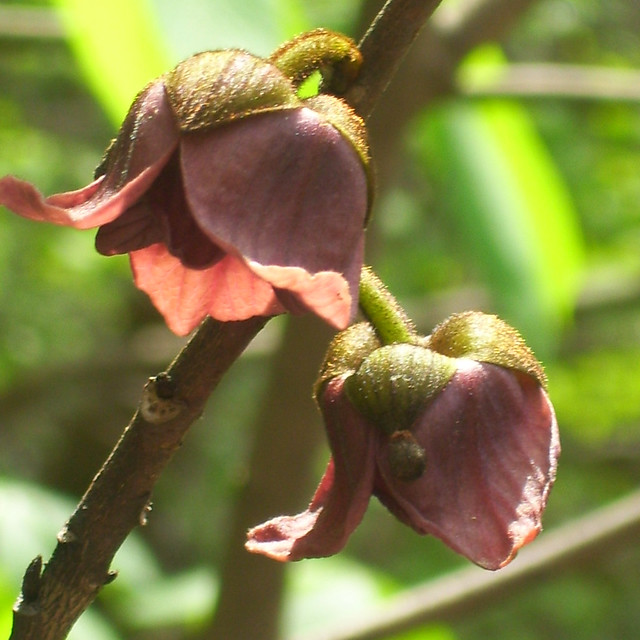
The flowers that do manage to get fertilized produce the largest edible fruit of any tree in North America. The lumpy fruit is technically a berry and can grow up to six inches long but is more often the size of a child’s fist. The green fruit often develops in clusters hidden beneath the huge leaves, typically ripening in late August through September in Virginia.
Pawpaw Fruits
In fall the fruit can be eaten straight from the trees or even made into different recipes. The fruit contains about 10 – 14 hard, inedible brown seeds in the center and has a soft custardy texture inside the inedible skin. The flavor is often compared to very ripe bananas, with hints of melon, or even pineapple, papaya and mango. In fact, the name Pawpaw itself is believed to be derived from the similar “papaya”.
In addition, when compared with apples, oranges, and bananas, the fruits are relatively high in protein and fat, with good amounts of vitamins C, riboflavin, and niacin, and of calcium, potassium, magnesium and several other useful minerals. It’s good to note that some people are sensitive to touching the fruit and break out into a rash.
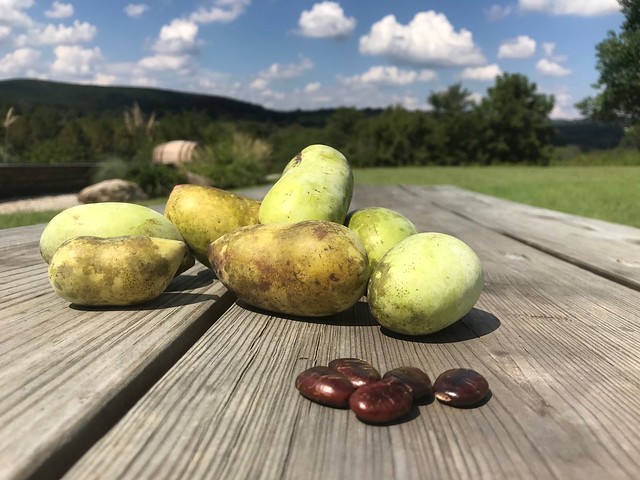
The fruit is savored by many species of wildlife as well as humans. Deer, racoons, opossums, squirrels, mice, wild turkeys and many other species of small mammals and birds eat the ripe fruit. In contrast, the crushed leaves smell bad and are extremely distasteful to deer and other herbivores and are rarely browsed. Pawpaws are the sole host for the beautiful Zebra Swallowtail Butterfly, whose caterpillars feed only on the foliage of Pawpaw, eating the tender new leaves and gaining protection from predators from the same chemical that makes the leaves so distasteful to herbivores.
Pawpaws are delicious eaten fresh from the tree as Lewis and Clark did on their trip and were a major component of Native American diets. They can be made into delicious pies, and puddings as Native Americans and early colonists did or even into ice cream as Pawpaw enthusiasts do today. Although be aware that some people are sensitive to touching the fruit and break out into a rash.
While there have been efforts to grow the fruit commercially, they have been largely unsuccessful. The fruits are easily bruised and don’t store well so that they are difficult to transport and market. Pollination problems resulting in relatively low fruit set are another problem.
Now that you are more familiar with these trees, be sure to take time and appreciate the stars of the Pawpaw Festival on September 16 at Powhatan State Park.
If you have read the article and have a question, please email nancy.heltman@dcr.virginia.gov.
Search for blogs
By Park
Categories
Cabins
Camping
Fishing
History and Culture
Other
Programs and Events
Trails
Volunteers
Water Fun
Archive
2024
2023
2022
2021
2020
2019
2018
2017
2016
2015
2014
2012














